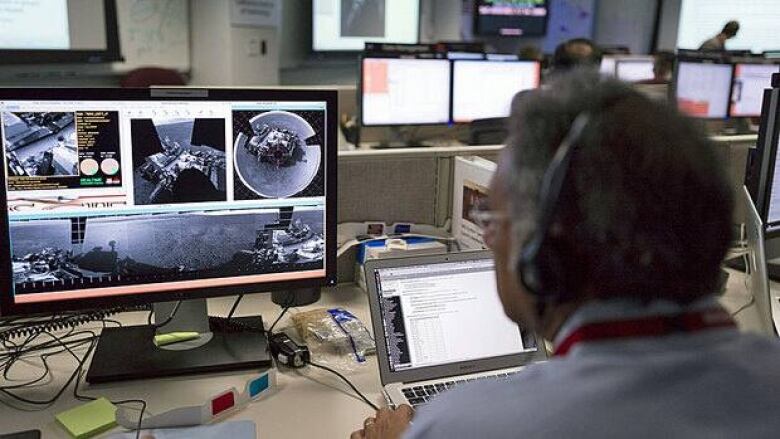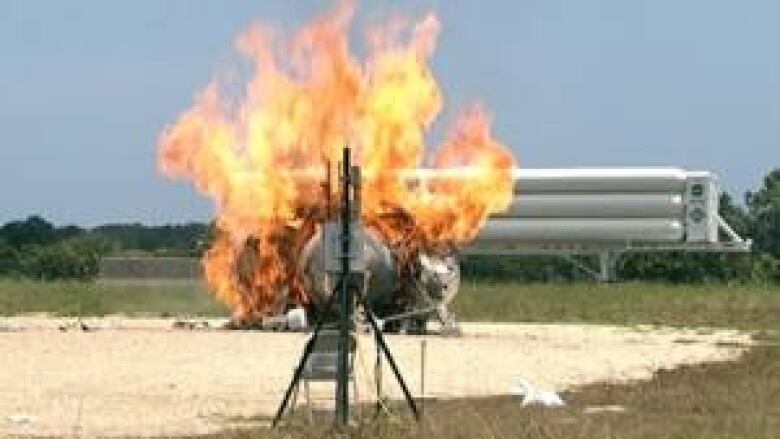Mars rover gets software upgrade to prepare for drive
NASA's final Curiosity mission briefing of the week comes after news of planetary lander crash

NASA gave its finalCuriosity missionbriefing of the week Friday, going over in more detail some aspects of the rover's landing on Mars and mapping out its next four days, which will be spentinstalling software thatthe robotwill need to drive around and explore the planet.
The software upgrade means the rover won't be doing any science over the next four sols, or Martian days,but will keep transmitting more of the data it collected during its high-speed landing on the planet Sunday night, NASA said.
The space agency said it has only a small fraction of the data so far and hopes as morearrives on Earth it will continue to get a clearer picture of howthe rover'slanding compares with the predictions andmodelsNASA spent years devising for the mission.
Now that the entry, descent and landing phases are complete, NASA programmers can shut down certain software applications needed for those activities, freeing up room for theprograms the rover needsto move and explorethe surface of Mars.
Rover's processor 10 times slower than smartphone
Those impressed by the rover'sspectacular high-speed-landing on Marswere surprised tolearn Fridaythat the rover is carrying out its complex mission with a fraction of the computing power of your average smartphone.

A smartphone has about 10 times the power and 16 times the storage space of the computer driving Curiosity, which has a 133MHz processor and 4GB of flash storage, NASA said Friday.
The space agency spent most of Friday's briefing breaking down certain aspects of the rover'slanding, such as how close the landing site was to the target NASA had chosen, and how well the parachute that helped bring the rover to the Mars surface performed.
The rover landed within the elliptical landing zone NASA had mapped out for it but deviated by about 2.4 kilometres from the precise spot where NASA engineers had predicted it would land because they did not have enough time to correct for certain deviations mid-flight, NASA said.
The landing was still the most precise of any of NASA's Mars rovers thanks to the use of a hypersonic guided entry technique similar to that used by astronauts returning to Earth during NASA's Apollo program, the space agency said.
Bad news day for NASA
The final Curiosity briefing of the week came a day after some less positive NASA news of a failed test flight of another spacecraft at the Kennedy Space Centerin Cape Canaveral, Fla.

The spider-shaped planetary lander Morpheus, billed as a new "green" type ofspacecraftthanks to its environmentally friendly propulsion fuel ofmethane and liquid oxygen, was barely off the ground before it tilted, crashed to the ground and erupted in flames on Thursday.
The space agency said thelander experienced ahardware component failure likely in apart of its GPS navigation system which prevented it from maintaining stable flight.
Nobody was hurt in the unmanned experiment, but the lander will likely not be repairable.
NASA has spent $7 million on the Morpheus program. That figure includes parts for a still-to-be-built second lander.
Although NASA said Thursday that "failures such as these were anticipated prior to the test and are part of the development process," there was no doubt that the crash put a bit of a damper on the otherwise good news storiesabout thesuccessful landingof Curiosity on Mars that have been coming out of the space agency all week.
The highlight of the daily briefingsNASA has been telecasting from its Jet Propulsion Laboratory in Pasadena, Calif., was acolour panoramic imageof the Mars landscape taken by a camera mounted on the rover's mast that was released Thursday.
Also on Thursday, NASAannouncedthat it would name the quadrangle where Curiosity landed Yellowknife after the northern Canadian city"that was the starting point for many of the great geological expeditions to map the oldest rocks in North America."
1st untethered test flight

Morpheus is a prototype for a cheap, environmentally friendly planetary lander that can carry a payload such as arobot, small rover or small scientificlaboratories to the moon or other celestial bodies such as asteroids.
It is one of 20 projects that make upNASA's Advanced Exploration Systems Program.
Thursday was the first time Morpheus had been tested untethered in a free flight. It had performed 19 flights at Johnson Space Center in Houston, where it was designed and made, and one more in Florida, but it was always tethered to a crane, NASA spokeswoman Brandi Dean told The Associated Press.
The testing moved from Texas to Florida last week, and Morpheus had a successful tether test last Friday. NASA had planned to run tests for three months. The plan was for flights over a specially created field designed to mimic the surface of the moon, with boulders, rocks, slopes and craters.
Environmentally friendly fuel
The lander was built mostly with low-cost, off-the-shelf materials. It was an attempt by NASA to use cheaper, more readily available rocket fuel that is more environmentally friendly than the toxic rocket fuels it usually uses.
Methane, which is the main component of natural gas,also has other advantages: it can be stored for longer times in space compared to other common rocket propellants, and could be made from ice found on the moon or Mars.
The International Space Station produces and dumps enough methane waste gas each year to fill the Morpheus fuel tanks, NASA said.
Morpheus was early in the NASA experimental "test bed" process, and the space agency hadn't committed to using the lander in any specific flight, NASA officials said.
The space agency has parts and plans to build a second Morpheus lander, Dean said.
"Hopefully, we'll be testing again before too long,"she said.
[IMAGEGALLERY galleryid=2881 size=large]
With files from The Associated Press












_(720p).jpg)


 OFFICIAL HD MUSIC VIDEO.jpg)
.jpg)



























































































